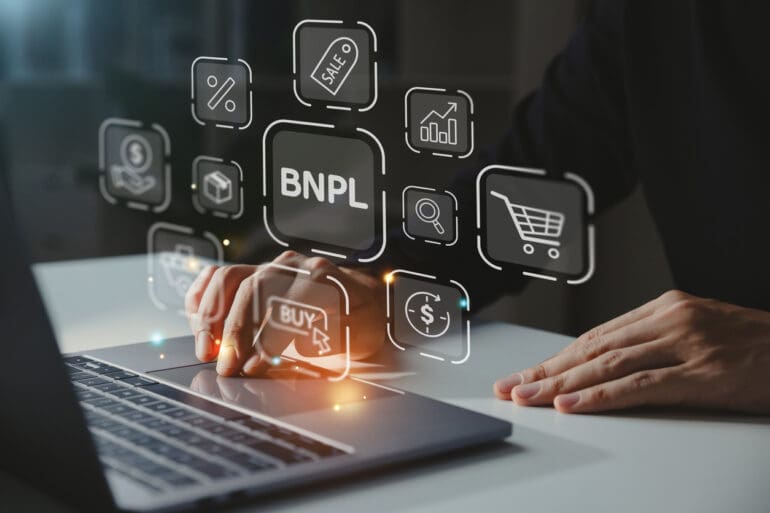With the cost of living skyrocketing and rising interest rates, consumers and businesses have been turning to brands that offer seamless, flexible payment and lending options.
And as customers and businesses navigate this difficult financial time, there’s a rising star: embedded lending. But this lending is not only a short-term solution to see customers through recessions or difficult times. Rather, it’s a sustainable solution that helps people with financial planning, becoming a major factor in every transaction and providing financing accessibility when needed. So, how is this different from Buy Now, Pay Later (BNPL) as we know it? Let’s explore.
The rise and almost-fall of BNPL
BNPL solutions addressing pain points with high credit card fees became popular during the pandemic alongside the rise of online shopping. This led various fintechs and intermediaries, like Klarna, to release customer-facing Pay in 3 or Pay in 4 options. These solutions became the standard deferred payment methods on every online site. However, the issue was many BNPL providers offered it to everyone without credit checks or reporting, resulting in late fees and untraceable debt for consumers.
Then came the perfect storm: Regulators started to closely observe the popularity of BNPL alongside a shift in the economy. This timely duo rattled the BNPL sector and caused responsible lending concerns, plummeting valuations, and rising interest rates. Large providers knew they’d have to either adapt—by limiting approvals and becoming more transparent—or suffer a major blow in the market.

Consumer downloads of BNPL apps have since declined and the number of BNPL providers has diminished, leaving a handful of global providers.
Embedded lending taking center stage
Embedded lending is the modernization and digitization of point-of-sale (POS) lending that’s been around for decades—a short-term loan from a bank, credit union, or regulated lender that allows consumers to make a purchase and pay it back in installments. For example, in the traditional sense, this POS lending could look like purchasing furniture and having to fill out paperwork for the loan in the store. However, this wasn’t an embedded experience for the customer, and it certainly wasn’t digital or user-friendly.
So, embedded lending is not a payment product but the reincarnation of regulated POS loans, taking learnings from what happened with BNPL into account.
The BNPL boom during the pandemic proved a need for convenient, frictionless payment options. But while accessibility is the core of BNPL and a key driver of financial inclusion, it must be achieved within a more regulated framework. Now, customers and merchants are after responsible and sustainable payment options embedded in the customer journey.
Comparing customization: What’s the loan type and location?
One of the characteristics of early BNPL was that it was online; nobody spoke about BNPL in-store, even though it existed in a traditional sense known as consumer POS finance. To deliver this online customer journey, merchants normally use a BNPL provider to add financing programs to checkout and enable their customers to pay in installments.
Embedded lending solutions, however, offer far more diverse access points for both B2C and B2B transactions, providing an omnichannel financing experience online, in-store, at home, or via call center.
Then, there’s the question of customization. What if merchants want a more seamless, branded financing experience for customers or to offer a wide range of personalized financial products?
Banks and merchants alike can partner with white-labeled embedded lending enablers to embed loan products in the most relevant way for each use case, creating a customer-centric financing experience. By matching the right type of financial solution—like installment loans, lines of credit, deferred invoices, and working capital—to the transaction, customer profile, and ticket size, consumers and businesses can access optimal financing solutions for their needs.
Also, there’s the possibility of a multi-lender waterfall solution that can smart-route a customer’s financing application from prime lender to secondary lender, ensuring high approval rates and customer conversions.
B2B vs. B2C: Which financing solution suits which market?
Once upon a time, traditional BNPL was mainly for smaller B2C transactions, and 75% of BNPL users were millennials or Gen Z. However, as businesses increasingly sell their products and services online to other businesses, BNPL has begun to gain traction in the B2B space. Whether ordering office supplies or furniture, business buyers expect the same smooth financing experience that they get as consumers.
However, remember that businesses are typically more risk-averse than consumers: They have traditionally swayed away from third-party BNPL providers that cannot offer a high level of security. Some of these providers also charge late fees or lack debt advice, which can impact customer relationships. Moreover, B2B often caters to larger loans and longer durations, which BNPL fintechs can find harder to provide.
That’s why, when the potential of embedded lending from regulated lenders came to light, demand from the B2B sector soared. Businesses are searching for ways to provide a unified customer experience globally, and embedded lending allows them to keep consistent branding and communication while following the local requirements and regulations. So, the added positive is that regulatory bodies do not threaten this lending model.
In fact, with 40% of BNPL users more willing to use BNPL from their banks over fintechs, businesses are starting to see the value of offering their own pay-over-time options by embedding loan and financing programs from banks. Companies can get their own B2B lending solution to market quickly using e-commerce plugins, virtual cards, or simple application programming interfaces (APIs) provided by embedded lending enablers.
B2C also requires an embedded lending mindset, especially for larger ticket items in retail and sectors such as healthcare, auto services and contractor projects. And, conscious of their brand equity, large corporate brands across many sectors are starting to make decisions to offer regulated products or question their current BNPL practices. Notice that Peloton now works with Citizens Pay, a leading bank in the point-of-sale financing/embedded lending space.
Closing comments
With an inflationary economy and goods and services costing more, consumers and businesses are increasingly looking for affordable payment alternatives to credit cards. And although the demand for BNPL options is continuing to grow, a rise in interest rates and customer protection concerns has made it more difficult for BNPL providers to operate. Banks and regulated lenders can capitalize on this opportunity as they have a lower cost of capital and powerful balance sheets to leverage, giving merchants the option to offer competitive, responsible embedded lending options (from the world’s leading banks and lenders).


